Examples of official dialogue on the Russian language. What is dialogue and monologue in Russian
This article answers the question: "What is dialogue and monologue?" It presents a characteristic of these two forms of speech, definitions, gives varieties of each of them, punctuation and other features. We hope that our article will help you to clarify in detail the differences between them, to learn something new for yourself.
Dialogue: Definition
Dialogue is a form of speech, which is a conversation between two or more persons, which consists of the exchange of cues between them. The main unit of dialogue is called dialogic unity - this is a thematic (semantic) association of several separate replicas into one, which is an exchange of statements, opinions, each of which is connected with the previous one and depends on it.
The existence of dialogical unity is explained by the connection of heterogeneous replicas (addition, distribution, narration, consent-disagreement, question-answer, speech etiquette formulas).
Sometimes it can exist thanks to statements that are not a reaction to the previous interlocutor of the interlocutor, but in general to the speech situation in which the conversation participant asks a counter question:
What is dialogue and monologue in your opinion?
What do you think?
The nature of the statements may depend on a variety of factors: first of all, on the personalities of the participants in the dialogue with their speech tactics and strategy, on their speech culture, the factor of having a “potential listener” (who does not participate in the conversation, although he is present at it), the degree of official environment in which communication takes place.
Types of Interaction

The code of relations of the participants in the conversation, i.e. their type of interaction. Three main types are distinguished: cooperation, dependence and equality. The degree of formality of the environment determines the control of those who are talking over their speech and compliance with language requirements and norms.
Dialogue structure
The dialogue on the Russian language always has a definite structure, in most types it remains the same: first the beginning, then the main part, and finally the ending. The reason can be one of the many formulas speech etiquette (Hello, Vasily Vladimirovich!) Or the first interrogative remark (What time is it?), As well as the replica-judgment (Wonderful weather today!).
It should be noted that the length of the dialogue can theoretically be infinite, because its lower boundary may remain open. Almost every dialogue on the Russian language can be continued by increasing the dialogic unity of which it consists. However, in practice, dialogical speech has an ending (a phrase of speech etiquette (Goodbye!), A replica-consent (Undoubtedly!), Or a replica-response).
Dialogue Features
Dialogue is a natural form of communication that is primary. Therefore, this form has received the greatest distribution. But dialogue (the definition of which was given above) is also present in journalistic, scientific and official business speech.
Dialogue conditions
For dialogue to arise, on the one hand, an initial common base of information is needed, which the participants will share, and on the other, it is necessary that there is a minimal difference in the knowledge of the participants in this speech interaction. Otherwise, they will not be able to transmit information to each other about the corresponding subject of speech, which means that the dialogue will be unproductive. That is, lack of information negatively affects the productivity of this form of speech. A similar factor can appear not only with low speech competence of the participants in the conversation, but also in the absence of their desire to start a dialogue or develop it.
A dialogue in which there is only one form of speech etiquette, called etiquette forms, has a formal meaning, in other words, it is not informative. At the same time, the participants have no need or desire to receive information, but the dialogue itself is formally generally accepted in some situations (for example, when meeting in public places):
Hello!
How are you?
Well thank you. And you have?
Everything is fine, I work slowly.
Well, bye, happily!
An indispensable condition for the emergence of dialogue aimed at obtaining new information is the need for communication. This factor arises as a result of a potential gap in the possession of information and knowledge between its participants.
Types of Dialogs
The following types of dialogs are distinguished according to the tasks and goals, roles of the interlocutors and the communication situation: business conversation, everyday dialogue and interviews.
Distinctive features of everyday dialogue are a possible deviation from the topic, unplannedness, lack of goals and the need for any decision, a variety of discussion topics, personal expression, widespread use of non-verbal (non-verbal) communication methods,
A business conversation is communication mainly between two participants in a conversation, which is therefore largely interpersonal. In this case, various techniques and methods of verbal and non-verbal influence of participants on each other are applied. A business conversation, although it always has a specific subject, is more personally oriented (in contrast, for example, from and occurs mainly between representatives of the same company.
Interview - communication of the press representative with someone whose personality is of public interest. Its distinctive feature is bi-address, that is, the interviewer (the one who conducts the interview), when addressing the addressee directly, builds a special dramaturgy of the conversation, relying primarily on the features of its perception by future readers.
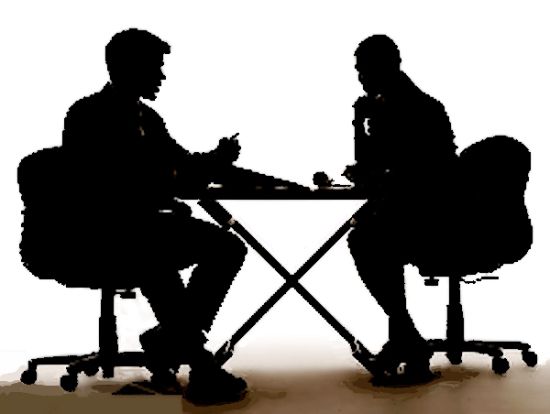
Dialogue punctuation
Spelling dialogues in Russian is a very simple topic. If the replicas of the speakers begin with a new paragraph, a dash is written before each of them, for example:
What is dialogue and monologue?
These are two forms of speech.
And how do they differ from each other?
The number of participants.
If the replicas are selected without indicating belonging to one or another person, each of them is drawn up in quotation marks and separated from the next one with a dash. For example: "What is dialogue and monologue?" - "Forms of speech." - "Thanks for the tip!".
If the words of the author follow the statement, the dash before the next of them is omitted: "How do you live?" asked Maria Petrovna. “Nothing, little by little,” Igor Olegovich answered.
Knowing these simple rules and applying them in practice, you can always correctly compose a dialogue.
Monologue: definition
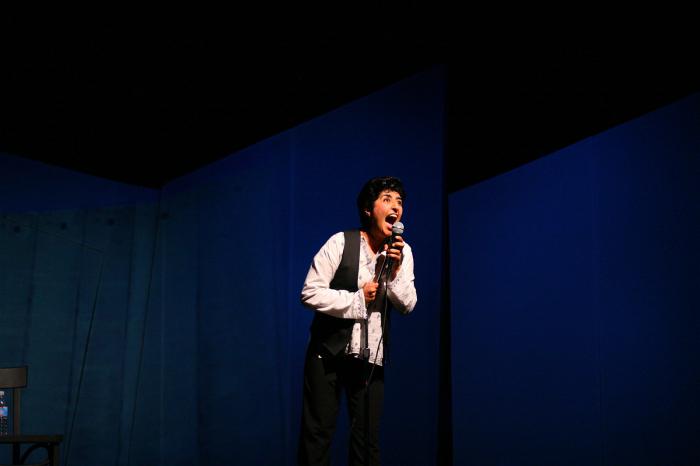
The monologue has a relative length in time (it consists of parts of different volumes, which are statements related in meaning and structure), and also differs in the variety and richness of the vocabulary. The themes of the monologue are very different, which can change spontaneously during its development.
Types of Monologue
It is customary to distinguish two main types of monologue.
1. Monological speech, which is a process of purposeful, conscious communication and appeal to the listener, is mainly used in the oral form of book speech: scientific oral (for example, a report or an educational lecture), oral public and judicial speech. The most developed monologue in art speech.
2. A monologue as speech alone with oneself, that is, directed not to the immediate listener, but to oneself. This kind of speech is called an "internal monologue." It is not designed to provoke a response of a person.

A monologue, the examples of which are numerous, can be both spontaneous, unprepared (most often it is used in colloquial speech), and pre-planned, prepared.
Types of monologue by purpose
According to the goal pursued by the statement, there are three main types: informational speech, persuading and inducing.
The main goal of information is the transfer of knowledge. The speaker in this case takes into account primarily the intellectual and perceptions of the text by the listeners.
A variety of information monologue are various performances, reports, lectures, reports, messages.
A convincing monologue is directed primarily to the emotions and feelings of the listener. The speaker first of all takes into account the susceptibility of the latter. To this kind of speech belong: solemn, congratulatory, parting words.
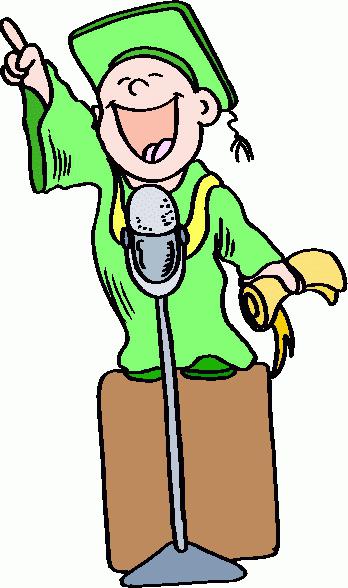
The motivating monologue (examples of which are very popular political speeches nowadays) is primarily aimed at encouraging listeners to various actions. It includes: speech-protest, political speech, speech-call to action.

Compositional form of a monologue
The monologue of man in its structure represents a compositional form, depending either on the functional-semantic or on the genre-stylistic affiliation. The varieties of the genre-stylistic monologue are distinguished by the following: oratory, official business and artistic monologue in the Russian language, as well as other types. Functional-semantic include narration, description, reasoning.
Monologues are different in degree of formality and preparedness. For example, oratorical speech is always a pre-planned and prepared monologue, which will certainly be pronounced in an official setting. But to some extent, it is an artificial form of speech, always striving to become a dialogue. Therefore, any monologue has various means of dialogue. These include, for example, rhetorical questions, appeals, question-answer form of speech, etc. In other words, this is all that indicates the desire of the speaker to increase the speech activity of his addressee-interlocutor, cause his reaction.
The monologue distinguishes between the introduction (in which the subject of the speech is determined by the speaker), the main part and the conclusion (in which the speaker summarizes his speech).
Conclusion
Thus, it can be noted that monologue and dialogue are the two main forms of speech that differ from each other in the number of subjects involved in communication. Dialogue is a primary and natural form, as a way of exchanging opinions and thoughts between its participants, and a monologue is a detailed statement in which the narrator is only one person. Both monologic and dialogical speech exist both verbally and in writing, although the latter is always based on dialogic and oral form.
For Russian language teachers
Lesson of the Russian language on the topic "Dialogue. Punctuation marks in the design of the dialogue in writing." 5th grade
1. To introduce students to the concept of “dialogue”.
2. Develop abilities and skills to make a dialogue on the proposed topic, to place punctuation marks in the dialogue.
3. To nurture a culture of speech.
During the classes
Psychological attitude to the lesson:
- I'm at school in a lesson,
- Now I will start to study.
“I rejoice at that.”
- My attention is growing.
“As a scout, I’ll notice everything.”
- My memory is strong
- The head thinks clearly.
- I want to learn.
“I'm ready to go.”
- I work.
At: Thanks. We are set to work.
- Today, guys, we will have an unusual lesson. You will try yourself in the role of actors, experts in the Russian language, writers and even editors.
And the goals and objectives for all of us will be common: we will have to solve
- what is dialogue?
- where does he meet in speech?
- how does it stand out in a letter?
But without your help, your active participation in the work, it will be difficult to do.
- So, open notebooks, write down the date, type of work (class work), topic of the lesson.
- And now, students in your class are staging a small poem by O. Grigoriev “Pit”.
Your task will be as follows: carefully listen to the poem and answer questions:
- How many characters are involved in the conversation?
- Which of the characters in the dialogue deserves judgment and why?
Staging a poem.
- Did you dig a hole?
- Digging.
- Did you fall into the pit?
- Fell.
“Are you sitting in the pit?”
- I'm sitting.
- Waiting for the stairs?
- I'm waiting.
- A cheese pit?
- Cheese.
- Like a head?
- Intact.
“So alive?”
- Alive.
- Well, I went home.
- So, a conversation between two or more persons is called a dialogue.
- And in what style of speech is dialogue most often used? (In colloquial style, in ordinary, everyday speech: at school, on the street, at home.) We encounter elements of dialogue every day.
Work with the terms “dialogue”.
MONO
POLY
Dialog
EPI
Missile defense
JOTE TOTS On each piece of paper, come up with one word related to the concept of “dialogue” (for example: conversation, information, etc.). pronounce this word loudly for your team members and write down on one piece of paper, put it face up in the center of the table. Each of you has 4 leaves. Total in the center of the table will be 16 leaves. Words should not be repeated.
Now leave any 9 cards in three rows on the table.
TIK-TEK-TOU Each team member makes 1 sentence using any three words on the same line (vertical, horizontal or diagonal) of these 9 cards. Choose the best offer and read it.
Reading, thinking. Please tell me how much time Olga asked.
1. Here is a sentence with direct speech. Write it down, place the necessary punctuation marks. Make a diagram. We help partners on the table.
2. See how the dialogue is formed on the letter.
Imagine my surprise when at dawn someone woke me in a thin voice. He said: A:
- Please ... draw me a lamb! - P!
- A? .. - P?
“Draw me a lamb,” a voice asked. - P, - a.
(Antoine de Saint-Exupery.)
So, what punctuation marks are put in the dialogue?
- The words of each of the participants in the dialogue are called a replica.
- Each new replica is written with a red line. A dash is placed in front of it.
- This sign helps to see the border between the statements of different participants in the dialogue.
Observation of the tongue.
Now we will meet you with a little playful poem, and you should think and answer:
- Is there a dialogue in this poem, and in what style of speech does it occur?
- Do you agree with the hero of the poem? Why is he wrong?
An expressive reading of Grigory Graubin’s poem “Lazy Case”.
Lezhebokin was asked:
- Well, tell me,
Why do you hate so much
Do not like cases?
Once upon a time all schoolchildren
They are known by heart.
And in two years to learn
You alone could not.
He answered angrily:
“That is not my fault.”
Let them first scientists
Change the names.
'Cause I'm a case
I’m not purposely teaching:
Work,
And even more so
Create
I do not want.
A case like Dative
I have not endured since childhood.
Giving, sharing
I don’t like friends.
Prepositional I hate:
So as not to learn a lesson,
Have to invent
Some excuse.
And on the accusative case
And I'm angry at all.
Father in all pranks
Always blames me.
- Yes, the alteration seems to be
Serious need.
And you yourself could new
Come up with names?
- For a long time thought up:
Vigorous,
Dirty
Lying
Rude,
Lazy
And finally Venial !
- Guys, is there Lezhebokin among you? Are you good friends?
The Mix-Freeze Group moves to the music, the music stops and a question is asked that requires a numerical answer, the children must unite:
1. How many cases in Russian? (6) Name them.
2. How many people usually engage in dialogue? (2)
3. How many main members of sentences in Russian? (2) Name them.
4. How many minor members are in the Russian language? (3) Name them.
- Where else can dialogue occur? (In an artwork, an artistic style.)
“Does fairy tales use dialogue?”
The brothers stood silently
yes in the back of the head scratched.
“Demand is not a sin. Forgive us, -
The elder said, bowing: -
if I don’t stutter
about that. ” - “I'm not angry, -
she said quietly: -
and my refusal is not the fault. ”
Grooms bowed to her,
slowly left
and according to everything again
began to live and live.
Let's try to recall from which fairy tale this passage? (“The Tale of the Dead Princess and the Seven Knights” by A.S. Pushkin.)
- Who is talking to whom?
“Why does the princess refuse the brothers?”
Observation of the tongue.
“But sometimes, using dialogue, we don’t notice that we are clogging up our speech with weed words.”
What do we do with weeds if we weed a bed? (Tear, destroy.)
- Right. Listen to a short text now and answer the question: “Why did the interlocutor not understand our hero? What prevented him? ”
Seryozha returned from the cinema.
- What, was the picture good? - I asked.
“Wow, that's great!” He answered. “First, it means that he suddenly finds out, and then, well, you see ... Well, in a word, it's just great ... Do you understand?
But I did not understand. He never managed to tell me plainly what he liked so much in the picture. He did not find the right words for such a story.
CLOCK BADIS Meet with your partner at 3 p.m. and discuss with him the answer to this question.
- Words-weeds clog our speech, impoverish it, do not expressively, accurately, vividly tell about the movie we liked, the book we read, make the speech poor and inexpressive. And you should avoid such words in your speech.
- But what words can we not refuse in any way, talking on the phone, buying groceries in a store, meeting or saying goodbye to each other?
Hello, goodbye, thank you, thank you, sorry, please.
- Why do you need to use these words in your speech? (You show your upbringing, knowledge of the rules of conduct, respectful attitude to the interlocutor.)
- Imagine this situation: you called a friend (girlfriend), but he (she) was not at home, and the mother picked up the phone. Where will you start and how will you end the dialogue?
Sample dialogue.
- Hello! Please call Kolya.
“And he is not at home.”
“Let him call me back when he arrives.”
- I will definitely pass it on.
- Thanks a lot. Excuse for troubling.
Lesson summary:
- So, what did we learn about dialogue today?
1. Dialog - a conversation of two or more persons.
2. The dialogue consists of replicas and words of the author.
3. Each replica is written from a new line through a dash.
4. Punctuation marks are put in the same way as in direct speech, but the dialogue is not highlighted with quotation marks.
5. The dialogue is used in colloquial and artistic styles.
6. It is necessary to use the author’s words correctly in the dialogue, avoiding weed words and repetitions.
Exit ticket.
Answer 1 of these questions in writing.
What is a DIALOGUE?
What punctuation marks are used in the DIALOGUE?
In what speech is the DIALOGUE most often used?
How do you understand what is a culture of communication?
Homework: Create a small dialogue on the topic: “Talking on the phone” using “magic words”.
Dialogue is one of four possible ways of including someone else's speech in the author’s text. We talked about the first three ways of transmitting someone else's speech in.
Foreign sentences recorded in this way fully retain both form and content. Direct or indirect speech is used by the authors when it is necessary to reproduce a phrase belonging to any one character, and dialogue (from the Greek dialogos - conversation) is used in cases where it is necessary to convey several replicas of the characters talking among themselves.
We will talk about punctuation of dialogical speech.
In the above text, you can easily distinguish the words of the author and the lines of characters: the first and last sentences are the author’s speech, inside which are two lines belonging to different characters. But one important difference between dialogue and direct indirect speech It is that in the dialogue the author’s words may not be present at all. Read the following dialog.
In order to remember how punctuation marks are placed when recording dialogue replicas, we can compare this form of recording someone else’s speech with the direct speech we already know. The design of the dialogue differs from the design of direct speech in that the remarks are not enclosed in quotation marks, but begin on a new line and with a dash. In the following examples, the same words are spelled in two ways. For the design of the dialogue, as well as for recording direct speech, there are four rules, each of which corresponds to the diagram in the illustration.
Legend:
R - A replica starting with a capital letter;
r - A replica starting with a lowercase letter
A - words of the author starting with a capital letter;
a - The author’s words starting with a lowercase letter.
– Do you need dead souls? - asked Sobakevich simply, without the slightest surprise ... (Gogol)
“Do you need dead souls?” Sobakevich asked simply, without the slightest surprise ...
He said:
- Hello! - and went to the window ... (Dragoon)
He said: “Hello!” - and went to the window.
Exercise number 1
Good evening, _ _ seemed just in case the Little Prince.
Good evening_, _ _ the snake shone.
What planet did I go to? _
To Earth, _ _ the snake showed. _ To Africa_.
Here is how. Are there no people on Earth? _
It is a desert. Nobody lives in the deserts. But the Earth is big_.
(Antoine de Saint-Exupery)
Exercise number 2
Can artist Woland be asked? _ _ okay Varenukha asked.
They are busy, _ _ the tube answered in a rattling voice, _ and who is asking?
Administrator Variete Varenukha.
Ivan Savelyevich? _ _ the pipe cried out hellishly. _ Terribly glad to hear your voice! How is your health?
Mercy, _ _ Varenukha viciously answered, _ _ who am I talking to?
His assistant, his assistant and translator Koroviev, _ _ was picking up the phone, _ _ at your service, dearest Ivan Savelyevich! Dispose of me as you please.
(Bulgakov)
Exercise number 3
I said_
Well how?
Monstrously! _ _ covered Boris Sergeevich.
Good song, right? _ _ I asked.
Good, _ _ said Boris Sergeyevich and covered his eyes with a handkerchief.
It’s only a pity that you played very quietly, Boris Sergeyevich, _ _ I said, _ _ it would be even louder.
Okay, I’ll take it into account, _ _ showed Boris Sergeyevich. _ _ didn’t you notice that I played one, and you sang a little differently?
No, _ _ I said, _ _ I didn’t notice this! Yes, it doesn’t matter. I just had to play louder.
Well, _ _ Boris Sergeyevich showed, _ _ az you didn’t notice anything, so far we’ll put you the top three. For diligence.
Dialog (from Greek. dialogos - conversation) - a conversation of two or more persons.
See how the dialogue takes shape, using the example of an excerpt from the fairy tale by A. de Saint-Exupery “The Little Prince” (Fig. 1).

Fig. 1. An example of a dialogue
Dialog consists of replicas of the persons involved and the words of the author. The words of each person in the dialogue (i.e., each new remark) are written a new line. Before them is placed dash. If the remark is accompanied by the words of the author, the same punctuation marks are used as in direct speech, but without quotation marks.
In the dialogue from V. Rasputin’s short story “French Lessons”, we’ll place punctuation marks (Fig. 2):
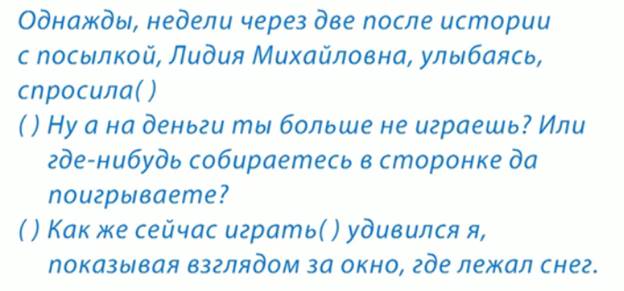
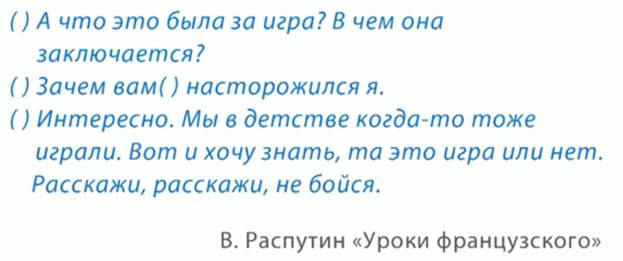
Fig. 2. Dialogue
Pay attention to the proposals (Fig. 3):
Fig. 3. Suggestions from the dialogue
The first sentence is preceded by a dash, replica, question mark, dash, author’s words (Fig. 4).
Fig. 4. Proposal from the dialogue
The second sentence is preceded by a dash, replica, question mark, dash, author’s words (Fig. 5).
Fig. 5. Proposal from the dialogue
Restore the dialogue by arranging the author’s remarks and words in the correct order (Fig. 6):
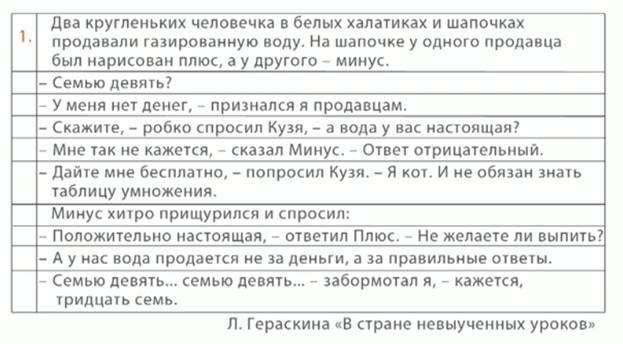
Fig. 6. Excerpt from the work
The result should be as follows (Fig. 7):
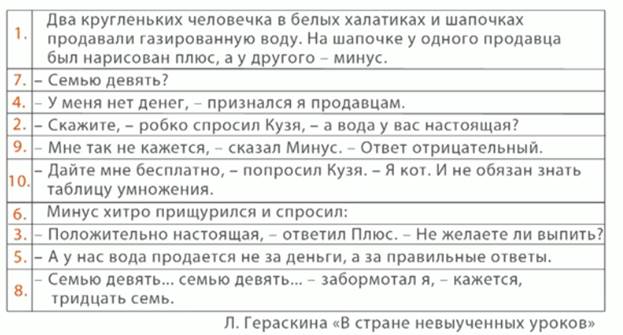
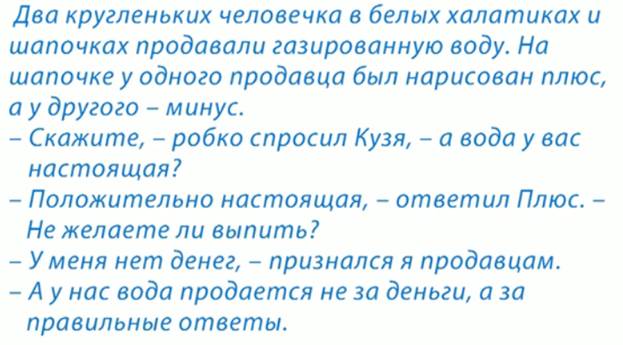
![]()
Fig. 7. Dialogue
List of references
- Lvov S.I., Lvov V.V. Russian language. 5th grade. In 3 parts. - 9th ed., Revised. - M .: 2012 Part 1 - 182 p., Part 2 - 167 p., Part 3 - 63 p.
- Ladyzhenskaya T.A., Baranov M.T., Trostentsova L.A. and other Russian language. 5th grade. The textbook in 2 parts. - M .: Education, 2012. - Part 1 - 192 p .; Part 2 - 176 p.
- Russian language. Grade 5 / Ed. Razumovskoy M.M., Lekant P.A. - M .: 2012 - 318 p.
- Rybchenkova L.M. and other Russian language. 5th grade. The textbook in 2 parts - M .: Education, 2014. - Part 1 - 127 p., Part 2 - 160 p.
- Internet portal "YaKlass" ()
- Internet portal “Festival of educational ideas“ Open lesson ”” ()
- Internet portal "Nsportal.ru" ()
Homework
- What is a dialogue?
- How are replicas of heroes written in a dialogue? But what about the words of the author?
- Can dialogue and direct speech be in the text at the same time?




